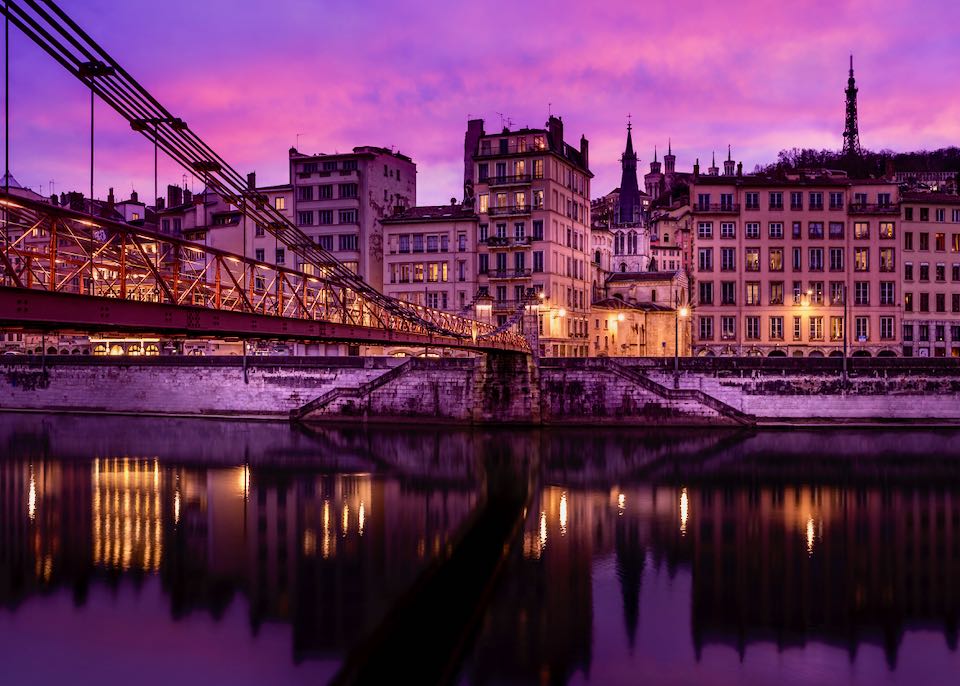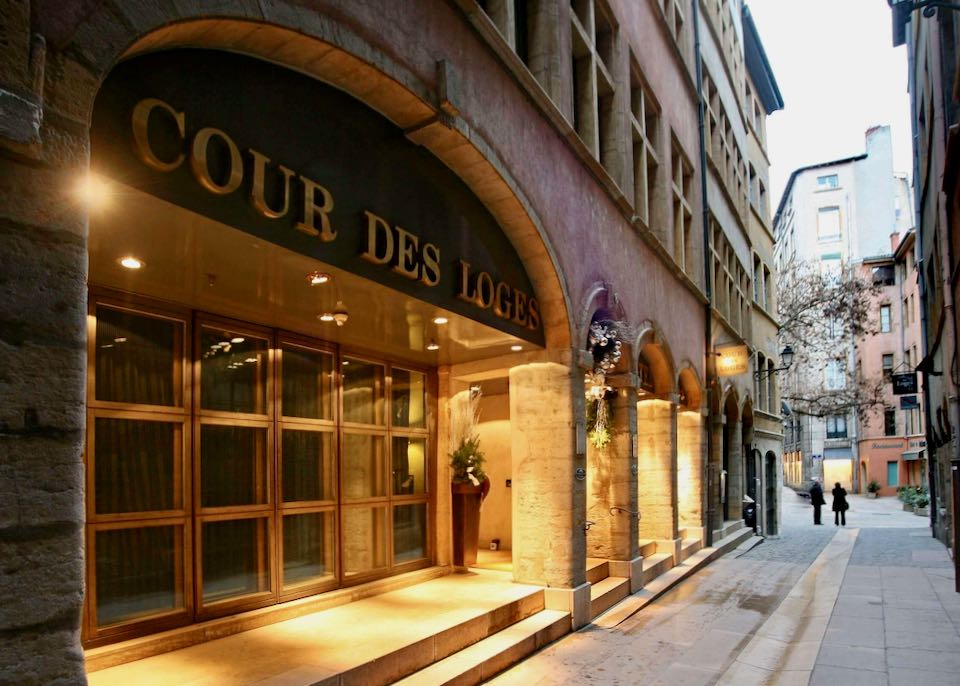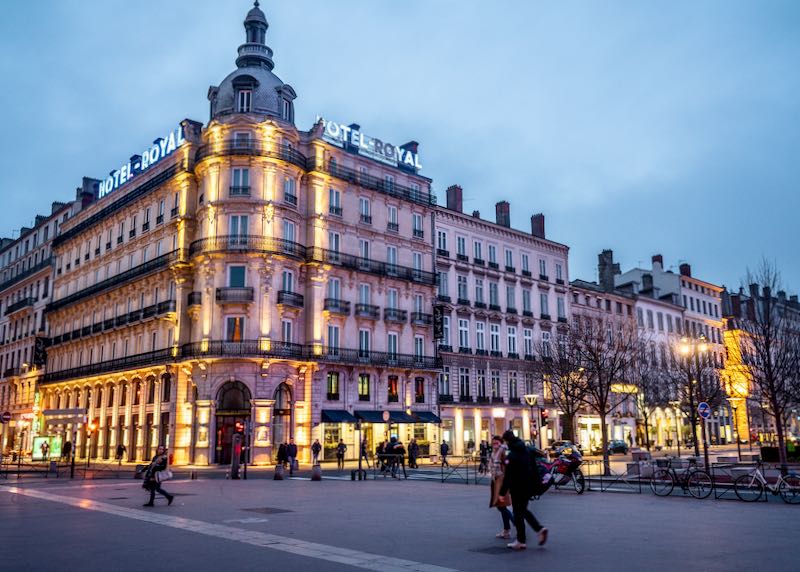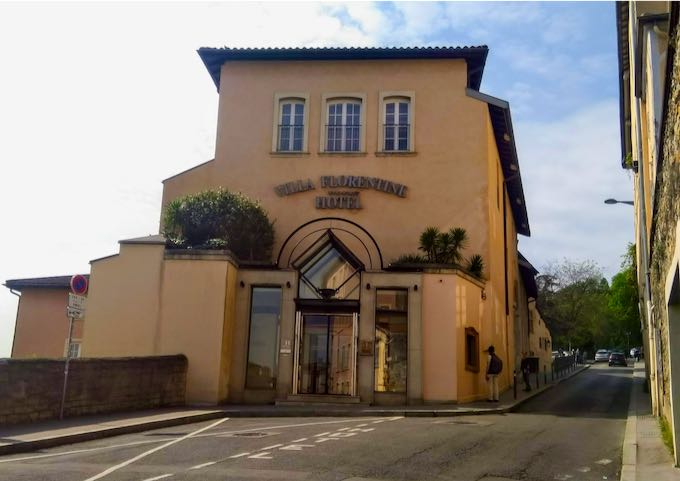
The banks of the Saône river in Lyon, France.
The Best Areas to Stay in Lyon
Lyon is a city of variety, with different neighborhoods having their own distinctive character, so your choice of where to stay will depend on the experience you want. There is no single best neighborhood for tourists; the main attractions are concentrated in the center, which is a pleasure to stroll around, but some make it worthwhile to take the metro or bus further out, and public transport links are good.
Many of the best hotels are also clustered in the center, particularly in Vieux Lyon and La Presqu’île. There are also great luxury accommodation options a little further out, especially in Fourvière, Brotteaux, and Part-Dieu. Look for good mid-range and budget options in Croix-Rousse, the Pentes, and Guillotière.
La Presqu’île is the city center, located on the narrow peninsula between the Rhône and Saône rivers. From Ampère in the south to Hôtel de Ville in the north, it is one of the grandest parts of the city, with its classic 19th-century French architecture. It is home to acres of high-end shopping, some of the city’s top attractions, and many pedestrianized streets lined with restaurants and bars, making it a tourist magnet. There is also a wide range of accommodation options and good transport links via Métro A and D.
Vieux Lyon lies to the west, across the Saône. The largest preserved Renaissance ‘old town’ in France, it is the most iconic – and the most touristy – part of the city. It’s full of colorful, Italianate palaces that now house some luxury hotels and cheaper guest houses. It’s also central and walkable, with bridges providing easy links to La Presqu’île and the Pentes de la Croix-Rousse.
Fourvière is the hill rising immediately west of Vieux Lyon. It’s a great location for Roman history buffs as well as view seekers, as it was the site of ancient Lugdunum. It’s mainly a residential area with some top attractions; there are some very exclusive hotels, but you can also find budget options. It is a bit further out from the center and the medieval streets are steep, but fortunately, there are also 2 funiculars linking the area to Vieux Lyon.
The Pentes (slopes) de la Croix-Rousse is to the north of La Presqu’île, rising via many stairs up to the Croix-Rousse plateau. It is a vibrant district with a bohemian feel, full of great eateries, bars, boutiques, and artist workshops. Just north of the city center, it’s easy to get to places by walking or using Métro C.
Croix-Rousse proper is further north, perched on the top of the hill. Once independent, this residential neighborhood still has a village feel, despite being a short walk or shorter Métro C ride to the center. Cheaper to stay than more central areas, there is plenty of great local food and some super museums focusing on the silk-weaving industry for which Croix-Rousse was well known.
Confluence is south of the central Presqu’île area, stretching from Perrache station to the junction of the rivers. This former industrial and port area has been overhauled by the largest urban regeneration project in Europe. Stay among cutting-edge, sustainable design, and enjoy great shopping, nightlife, and the very cool Musée des Confluences. A bit further from other attractions but connected via the T1 tram.

The wonderful Cour des Loges boutique hotel in the heart of Lyon’s Old Town.
Guillotière lies on the Rive Gauche (east bank) of the Rhône, from roughly around Cours Gambetta in the north to around Avenue Berthelot in the south. Young, multicultural, and rapidly gentrifying, this area is becoming an alternative cultural hub with great restaurants, bars, and galleries popping up. Accommodation is cheaper and there are good links to the center via Métros B and D.
Part-Dieu is north of Pont de la Guillotière, between the Rhône and Part-Dieu station. This is the financial district, with landmark skyscrapers, gourmet food at Les Halles de Lyon Paul Bocuse, few attractions, and good shopping. Mainly chain hotels but also nice guesthouses. Close to the center just across the Rhône, with great bars and live music venues along the river. Part-Dieu station offers direct train links to Paris and trams to Lyon Saint-Exupéry airport.
Brotteaux is an upscale residential neighborhood north of the Part-Dieu district, starting at Pont Lafayette. Luxury apartment buildings and hotels abound, as do top restaurants and bars, though the area is lower on attractions. However, there are excellent transport links to the center and the airport via Métro A and B.
Cité Internationale is located north of Brotteaux, around the huge Parc de la Tête d’Or. It centers on a new complex designed by Renzo Piano, which includes luxury apartments and hotels as well as the Musée d’Art Contemporain. Further away from other sights, but buses and Métros A and B will get you where you need to go.
The Best Places to Stay in Lyon
Hotel Le Royal in La Presqu’ile neighborhood.
- Best Luxury Hotels in Lyon
Hotel Le Royal • Villa Maïa • Villa Florentine- Best Boutique Hotels in Lyon
Cour des Loges • Collège Hotel • Okko Hotels Pont Lafayette- Best Cheap Hotels in Lyon
Mob Hotel • Slo Living Hostel • Away HostelBest Areas in Lyon for…
- Best Area in Lyon for Sightseeing: Vieux Lyon
Sightseeing in Vieux Lyon is a matter of simply turning the corner to admire more of the medieval and Renaissance architecture that makes it a UNESCO World Heritage Site. Go looking for traboules, secret passages mainly constructed by silk weavers to transport their goods. If art museums and 19th-century architecture are your passion, make your way over to La Presqu’île for such gems as the Musée des Beaux Arts.- Best Area in Lyon for Nightlife: Guillotière
Great areas for going out at night are spread across the city. The Confluence has music venues such as Marché Gare and clubs including Le Sucre, where you can dance to popular electronic DJs on the roof of a sugar factory turned modern art gallery. In the Pentes de la Croix-Rousse, there are funky bars and music venues clustered around Croix-Paquet and Montée de la Grande-Côte. La Presqu’île has some very cool cocktail bars, especially in Grand Hôtel-Dieu. Floating bars hosting DJs line the bank of the Rhône in Part-Dieu. But for the newest and hottest spots, a great mix of craft beer, cocktails, and concert venues, head to Guillotière.- Best Area in Lyon for Food and Restaurants: Pentes de la Croix-Rousse
In food-obsessed Lyon, there is serious competition for the area with the best eating. Multicultural Guillotière has plenty of places for delicious informal dining, from French to Swedish and Korean food. Part-Dieu has Les Halles de Lyon Paul Bocuse, the famous indoor market filled wall-to-wall with quality food. Brotteaux is great for high-end dining, with multiple Michelin-starred places such as Pierre Orsi, as well as Bernachon for some of the best chocolates and cakes in the city. La Presqu’île has many restaurant gems, both relaxed and formal. The Pentes de la Croix-Rousse has some of the most varied and tastiest cuisines, concentrated around Rue de la Martinière in the west and Rue Royale in the east.- Best Areas in Lyon for Families: Brotteaux, Cité Internationale, and Croix-Rousse
Brotteaux and Cité Internationale are good choices, being mainly quiet residential areas close to Parc de la Tête d’Or. The park is vast and contains a lot of family-friendly attractions, including a boating lake, large free zoo, mini karting, a little train that goes on a tour of the park, and a Guignol puppet theater. Croix-Rousse is also a good choice and more affordable, with a gentler, friendly atmosphere. You are away from the tourist crowds but with easy links to the center. There are fun food and flea markets, La Vogue aux Marrons carnival in October and November, and parks to unwind in such as Parc de la Cerisaie.- Best Area in Lyon to Stay for First Timers: Presqu’île
You can’t go wrong if you base yourself in Vieux Lyon – it’s central, packed with sights, and feels like you’ve been transported back in time. The area has accommodations to suit any budget.- Most Romantic Area in Lyon: Vieux Lyon
Fourvière offers giddy views from exclusive hotels and restaurants high above the bustle of the city. Brotteaux has elegant dining and boutiques along Cours Vitton. The Pentes de la Croix-Rousse has a bohemian air and lovely stays in traditional tall houses originally built as silk-weaving workshops. But for no-holds-barred romance, luxury hotels, fine dining, and charming views all in one place, it has to be Vieux Lyon.- Best Area in Lyon for a Local Vibe: Croix-Rousse
Croix-Rousse was once an independent town and retains that spirit. It is still full of independent businesses and restaurants and hosts a popular food market as well as an autumn carnival, La Vogue aux Marrons. Guillotière is part of the young, creative, up-and-coming 7th arrondissement, and travelers looking for art and an alternative vibe will find it here.- Best Areas in Lyon for Walking: Vieux Lyon and La Presqu’île
Much of Lyon is a pleasure to walk around with plenty of pedestrianized areas. The narrow cobbled streets of Vieux Lyon practically demand that you get lost in them. La Presqu’île is also very walkable. The stairways of the Pentes de la Croix-Rousse and Fourvière are fun to explore on foot, though you may also be grateful for the metro and funicular on your return.- Safest Areas of Lyon
Residential areas – Brotteaux, Cité Internationale, Fourvière, Croix-Rousse – tend to be very safe. Vieux Lyon and the Pentes de la Croix-Rousse are also safe but very touristy, so the usual precautions against pickpockets apply. Streets with lots of bars, such as Rue Sainte Catherine in the Pentes, are great but get lively and pretty loud at night.- Unsafe Areas of Lyon
The area around Perrache is being rejuvenated but can feel a bit sketchy at night. The surroundings of the Guillotière métro are also grungy, but for both, it is sufficient to take normal precautions at night. The rest of Guillotière is very safe and tourists are more likely to run into problems such as pickpockets in the center.The 10 Best Neighborhoods in Lyon for Tourists
Villa Florentine hotel in the Vieux Lyon neighborhood.
1. La Presqu’ile
The UNESCO-protected heart of Lyon sits pretty between the Rhône and Saône, bounded to the north by the Pentes (slopes) de la Croix-Rousse and to the south by Perrache station and the Confluence. It oozes French charm, with streets of classic 19th-century architecture and picturesque squares with fountains such as Place des Terreaux and Place des Jacobins. It’s the city’s main shopping area – look for designers on Rue de Brest and the parallel Rue du Président Édouard Herriot, and more accessible fashion along Rue de la République. There are lots of top attractions here too, including the Musée des Beaux Arts, Église St. Nizier, Musée des Tissus et des Arts Décoratifs, and Musée de l’Imprimerie – the latter two commemorating Lyon’s history as a silk-weaving and printing center. Many streets are pedestrianized and lined with restaurants and bars; there are lively areas for going out particularly around Rue de la République and the newly developed Grand Hôtel-Dieu. Excellent luxury hotels along with more affordable options are available in the area.
- Best Hotels: Hotel Le Royal • Sofitel Bellecour • MiHotel Gailleton
- Best Cheap/Moderate Hotel: Hotel Le Boulevardier
2. Vieux Lyon
The medieval and Renaissance center of Lyon stood here, on the west bank of the Saône, before it gradually crept further east. What remains is a remarkably preserved riot of Italian colors and narrow streets filled with luxury townhouses from the days when Lyon was a trading and banking hub on the route between Italy and the Netherlands. The atmosphere in this UNESCO-protected area with its hidden traboules is second-to-none, though it does get busy with tourists. The attractions include the Gothic/Romanesque cathedral, museums both fine and quirky, and boutiques and artisans’ workshops for buying unique gifts. The dining scene is mostly touristy, though there are some standout restaurants, including Michelin-starred ones. You can also stay in a guest house or boutique hotel inside one of the beautiful period buildings.
- Best Hotels: Villa Florentine • Cour des Loges
- Best Cheap/Moderate Hotels: Collège Hotel • Hôtel Saint Paul
3. Fourvière
‘The hill that prays’ and its peaceful residential neighborhood overlook the city from the west. Steep medieval streets, some of them long stairways, snake up from Vieux Lyon to the top, where the views are tremendous; alternatively, there are also two funiculars. The finest remains of Roman Lugdunum are here – an aqueduct, two Roman theaters, and a wonderful adjoining museum of Gallo-Roman history. Crowning the hill are the iconic white Basilique Notre Dame de Fourvière and its neighbor, the Tour Métallique, which looks like a mini Eiffel Tower. There are both fine dining restaurants and casual cafes and bars, and some lovely hotels.
- Best Hotels: Villa Maïa • Fourvière Hotel
- Best Cheap/Moderate Hotel: Home Sweet Home
4. Pentes de la Croix-Rousse
North of the Hôtel de Ville, the pretty, bohemian Pentes rise uphill with many stairs. In the 19th century, this area was populated by silk weavers and was full of workshops for the ‘canuts’, as they were known; because of them, Croix-Rousse is ‘the hill that works’. The canuts have mostly gone, but the distinctive architecture and artistic spirit remain. For independent boutiques and artist workshops, check out Montée de la Grande-Côte and the Village des Créateurs. For traboules, head to Rue Imbert Colomès and Rue René Leynaud in particular. It’s also a great place to find cool bars and clubs (especially on Rue Sainte Catherine and Croix-Paquet), cafes, and alternative music venues. The restaurant scene is one of the best in the city, with hot newcomers jostling with old favorites – check out the areas around Rue de la Martinière in the west and Rue Royale in the east. Accommodations tend towards guest houses rather than elegant hotels, but with ample comfort and atmosphere.
- Best Hotel: Hotel Saint Vincent
- Best Cheap/Moderate Hotels: Away Hostel • Opéra
5. Croix-Rousse
A lively residential neighborhood on the plateau north of the Pentes, Croix-Rousse is a village within the city. It’s a great area to investigate and get some local flavor off the tourist trail. The neighborhood is cheaper than the center and its eastern part is full of 19th-century canut apartments. There are a lot of affordable local restaurants, cafes, and bars – look particularly around Rue de Belfort and Rue du Mail. There are also lovely hidden squares and gardens to discover such as the Jardin Rosa Mir. Attractions include the food market on the Boulevard de la Croix-Rousse, which is held every day but Monday, the epic fresco Mur des Canuts, and a couple of museums and workshops where you can experience the area’s silk-weaving history such as Maison des Canuts.
- Best Hotels: Les Loges du Théâtre • Hôtel Lyon Métropole
- Best Cheap/Moderate Hotel: Villa des Canuts
6. Confluence
A radical departure from the historic center, the Confluence, where the rivers meet, is all daringly modern design. Where once there was an industrial wasteland south of Perrache, now it’s the most contemporary and one of the most striking parts of the city. Landmarks include quirky office buildings nicknamed Le Cube Orange and Le Cube Vert, and at the southern point, the futuristic Musée des Confluences – a science and anthropology museum that is equally spectacular on the inside. It’s still in development as a residential area but is already a place for great shopping, at the huge (and pleasing to the eye) Pôle de Commerces and de Loisirs Confluence, a shopping complex so big it runs its own boat service, the Vaporetto. The nightlife is a big draw, with bars dotted particularly along the river Saône, and big music venues and clubs such as Marché Gare and Le Sucre. The latter sits on the roof of La Sucrerie, a gallery that hosts everything from contemporary art shows to vintage markets and the Nuits Sonores music festival.
- Best Hotel: Novotel Confluence
- Best Cheap/Moderate Hotel: Mob Hotel
7. Guillotière
South of the financial district of Part-Dieu, on the Rive Gauche, Guillotière is studenty, creative, and flourishing. Changing fast due to gentrification, but still, with an alternative edge, it has taken over as the new young arty hub of the city from the Pentes. Restaurants are fantastic and varied in this multicultural district, and it has attracted some of the trendiest new bars, clubs, and galleries. Along the river are the Berges du Rhône, with miles of walking and cycling paths, and the Piscine du Rhône, with two lovely outdoor pools, one with fountains and slides. Other attractions include the Art Deco Citroën building and the Centre d’Histoire de la Résistance et de la Déportation (CHRD), a museum on the French Resistance in Lyon during WWII.
- Best Hotel: Mama Shelter
- Best Cheap/Moderate Hotels: Le Flâneur Guesthouse • ho36 Hostel
8. Brotteaux
Elegant Brotteaux is to the north of the financial Part-Dieu district. Wide boulevards are lined with mansions in which luxury apartments can be rented, and there’s fine shopping to be had, with antique shops and boutiques concentrated around Cours Vitton. Some of the best fine dining in the city, with 5 Michelin-starred places, including the traditional Pierre Orsi and the modern Peruvian Miraflores, can be found here. It is low on attractions but features easy access to the green space of Parc de la Tête d’Or to the north, and the center and the Pentes de la Croix-Rousse across the river.
- Best Hotel: Okko Hotels Pont Lafayette
- Best Cheap/Moderate Hotels: Chez Tatiana • Hotel le Roosevelt
9. Cité Internationale
Centered on the expanse of the Parc de la Tête d’Or and bounded by the Rhône, this neighborhood features ambitious modern architecture by Renzo Piano. There are luxury apartments and hotels, a cinema, and a huge conference center which also hosts musicals and exhibitions (as well as several consulates and the office of Interpol.) Highlights include the Musée d’Art Contemporain, which hosts temporary exhibitions of artists like Andy Warhol and Yoko Ono. Of course, the major one is the Parc de la Tête d’Or itself, pretty and restful, with a host of different attractions inside, including rose gardens, a free zoo, tropical greenhouse, Guignol puppet theater, and boating lake.
- Best Hotels: Warwick Reine Astrid • Marriott Cité Internationale
- Best Cheap/Moderate Hotel: Montempô Cité Internationale
10. Part-Dieu
Lyon’s modern and bustling financial district lies on the Rive Gauche, between Cours Gambetta to the south and Cours Lafayette in the north. Hotels are geared mainly towards business travelers, unsurprisingly, and the area is low on attractions; however, there are gems for tourists if you look for them. For instance, there’s the foodie pilgrimage site of Les Halles de Lyon Paul Bocuse, the main indoor food market, watched over by a mural of the great chef himself. The city’s landmark skyscrapers are here, known as the Pencil and the Eraser. In the west, the parks and bike paths of the Berges du Rhône are delightful; there are also excellent bars, some doubling as live music venues along and on the river itself.
- Best Hotel: Radisson Blu
- Best Cheap/Moderate Hotel: SLO Living Hostel


About Santorini Dave